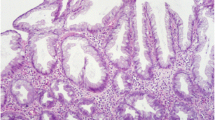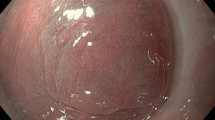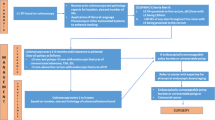Abstract
For several years, the lack of consensus on definition, nomenclature, natural history, and biology of serrated polyps (SPs) of the colon has created considerable confusion among pathologists. According to the latest WHO classification, the family of SPs comprises hyperplastic polyps (HPs), sessile serrated adenomas/polyps (SSA/Ps), and traditional serrated adenomas (TSAs). The term SSA/P with dysplasia has replaced the category of mixed hyperplastic/adenomatous polyps (MPs). The present study aimed to evaluate the reproducibility of the diagnosis of SPs based on currently available diagnostic criteria and interactive consensus development. In an initial round, H&E slides of 70 cases of SPs were circulated among participating pathologists across Europe. This round was followed by a consensus discussion on diagnostic criteria. A second round was performed on the same 70 cases using the revised criteria and definitions according to the recent WHO classification. Data were evaluated for inter-observer agreement using Kappa statistics. In the initial round, for the total of 70 cases, a fair overall kappa value of 0.318 was reached, while in the second round overall kappa value improved to moderate (kappa = 0.557; p < 0.001). Overall kappa values for each diagnostic category also significantly improved in the final round, reaching 0.977 for HP, 0.912 for SSA/P, and 0.845 for TSA (p < 0.001). The diagnostic reproducibility of SPs improves when strictly defined, standardized diagnostic criteria adopted by consensus are applied.



Similar content being viewed by others
References
Snover DC, Ahnen DJ, Burt RW, Odze RD (2010) Serrated polyps of the colon and rectum and serrated polyposis. In: Bosman FT, Carneiro F, Hruban RH, Theise ND (eds) WHO classification of tumours of the digestive system, 4th edn. IARC, Lyon, pp 160–165
Longacre TA, Fenoglio-Preiser CM (1990) Mixed hyperplastic adenomatous polyps/serrated adenomas. A distinct form of colorectal neoplasia. Am J Surg Pathol 14:524–537
Torlakovic E, Skovlund E, Snover DC, Torlakovic G, Nesland JM (2003) Morphologic reappraisal of serrated colorectal polyps. Am J Surg Pathol 27:65–81
Higuchi T, Sugihara K, Jass JR (2005) Demographic and pathological characteristics of serrated polyps of colorectum. Histopathology 47:32–40
Snover DC, Jass JR, Fenoglio-Preiser C, Batts KP (2005) Serrated polyps of the large intestine: a morphologic and molecular review of an evolving concept. Am J Clin Pathol 124:380–391
Cunningham KS, Riddell RH (2006) Serrated mucosal lesions of the colorectum. Curr Opin Gastroenterol 22:48–53
Goldstein NS (2006) Serrated pathway and APC (conventional)-type colorectal polyps: molecular–morphologic correlations, genetic pathways, and implications for classification. Am J Clin Pathol 125:146–153
Torlakovic E, Snover DC (2006) Sessile serrated adenoma: a brief history and current status. Crit Rev Oncog 12:27–39
Torlakovic EE, Gomez JD, Driman DK et al (2008) Sessile serrated adenoma (SSA) vs. traditional serrated adenoma (TSA). Am J Surg Pathol 32:21–29
Hirano H, Ajioka Y, Watanabe H et al (2004) Bidirectional gastric differentiation in cellular mucin phenotype (foveolar and pyloric) in serrated adenoma and hyperplastic polyp of the colorectum. Pathol Int 54:401–407
Noffsinger AE (2009) Serrated polyps and colorectal cancer: new pathway to malignancy. Annu Rev Pathol 4:343–364
Goldstein NS, Bhanot P, Odish E, Hunter S (2003) Hyperplastic-like colon polyps that preceded microsatellite-unstable adenocarcinomas. Am J Clin Pathol 119:778–796
Hirono H, Ajioka Y, Watanabe H, Baba Y, Tozawa E, Nishikura K, Mukai G, Honma T, Aoyagi Y (2004) Bidirectional gastric differentiation in cellular mucin phenotype (foveolar and pyloric) in serrated adenoma and hyperplastic polyp of the colorectum. Pathol Int 54:401–407
Li SC, Burgart L (2007) Histopathology of serrated adenoma, its variants, and differentiation from conventional adenomatous and hyperplastic polyps. Arch Pathol Lab Med 131:440–445
Bauer VP, Papaconstantinou HT (2008) Management of serrated adenomas and hyperplastic polyps. Clin Colon Rectal Surg 21:273–279
Jass JR, Young J, Leggett BA (2000) Hyperplastic polyps and DNA microsatellite unstable cancers of the colorectum. Histopathology 37:295–301
Jass JR, Young J, Leggett BA (2002) Evolution of colorectal cancer: change of pace and change of direction. J Gastroenterol Hepatol 17:17–26
Jass JR (2005) Serrated adenoma of the colorectum and the DNA-methylator phenotype. Nat Clin Pract Oncol 2:398–405
O’Brien MJ, Yang S, Mack C et al (2006) Comparison of microsatellite instability, CpG island methylation phenotype, BRAF and KRAS status in serrated polyps and traditional adenomas indicates separate pathways to distinct colorectal carcinoma end points. Am J Surg Pathol 30:1491–1501
Goldstein NS (2006) Small colonic microsatellite unstable adenocarcinomas and high-grade epithelial dysplasias in sessile serrated adenoma polypectomy specimens: a study of eight cases. Am J Clin Pathol 125:132–145
Jass JR (2007) Classification of colorectal cancer based on correlation of clinical, morphological and molecular features. Histopathology 50:113–130
Bariol C, Hawkins NJ, Turner JJ, Meagher AP, Williams DB, Ward RL (2003) Histopathological and clinical evaluation of serrated adenomas of the colon and rectum. Mod Pathol 16(5):417–423
Farris AB, Misdraji J, Srivastava A, Muzikansky A, Desphande V, Lauwers GY, Mino-Kenudson M (2008) Sessile serrated adenoma. Challenging discrimination from other serrated colonic polyps. Am J Surg Pathol 32:30–35
Wong NACS, Hunt LP, Novelli MR, Shepard NA, Warren BF (2009) Observer agreement in the diagnosis of serrated polyps of the large bowel. Histopathology 55:63–66
Khalid O, Radaideh S, Cummings OW, O’Brien MJ, Goldblum JR, Rex DK (2009) Reinterpretation of histology of proximal colon polyps called hyperplastic in 2001. World J Gastroenterol 15:3767–3770
Glatz K, Pritt B, Glatz D, Harmann A, O’Brien MJ, Blaszyk H (2007) A multinational, internet-based assessment of observer variability in the diagnosis of serrated colorectal polyps. Am J Clin Pathol 127:938–945
Sandmeier D, Seelentag W, Bouzourene H (2007) Serrated polyps of the colorectum: is sessile serrated adenoma distinguishable from hyperplastic polyp in daily practice? Virchows Arch 450:613–618
Bustamente-Balen M, Bernet L, Cano R, Morell L, Lopez A (2009) Assessing the reproducibility of the microscopic diagnosis of sessile serrated adenoma of the colon. Rev Esp Enferm Dig (Madrid) 101:258–264
Gunia S, Berg T, Gradhand E, Becker S (2011) Knowledge of the anatomical polyp location might bias the pathological classification of histologically equivocal colorectal serrated polyps—a consensus study performed by pathology trainees. Path Res Pract 207:116–120
Denis B, Peters C, Chapelain C, Kleinclaus I, Fricker A, Wild R, Auge B, Gendre I, Perrin P, Chatelain D, Flejou JF (2009) Diagnostic accuracy of community pathologists in the interpretation of colorectal polyps. Eur J Gastroenterol Hepatol 21:1153–1160
Chung SM, Chen YT, Panczykowski A, Schamberg N, Klimstra DS, Yantiss RK (2008) Serrated polyps with “intermediate features” of sessile serrated polyp and microvesicular hyperplastic polyp: a practical approach to the classification of nondysplastic serrated polyps. Am J Surg Pathol 32:407–412
Ensari A, Bosman FT, Offerhaus GJA (2010) The serrated polyp: getting it right! J Clin Pathol 63:665–668
Landis JR, Koch GG (1977) The measurement of observer agreement for categorical data. Biometrics 33:159–174
Aust DE, Baretton GB (2010) Serrated polyps of the colon and rectum (hyperplastic polyps, sessile serrated adenomas, traditional serrated adenomas, and mixed polyps)—proposal for diagnostic criteria. Virchows Arch 457:291–297
Sheridan TB, Fenton H, Lewin MR et al (2006) Sessile serrated adenomas with low- and high-grade dysplasia and early carcinomas: an immunohistochemical study of serrated lesions “caught in the act”. Am J Clin Pathol 126:564–571
Hamilton SR, Vogelstein B, Kudo S et al (2000) Carcinoma of the colon and rectum. In: Hamilton SR, Aaltonen IA (eds) Tumours of the digestive system. WHO classification of tumours. IARC, Lyon, pp 113–114
Conflict of interest
The authors declare that they have no conflict of interest.
Author information
Authors and Affiliations
Corresponding author
Rights and permissions
About this article
Cite this article
Ensari, A., Bilezikçi, B., Carneiro, F. et al. Serrated polyps of the colon: how reproducible is their classification?. Virchows Arch 461, 495–504 (2012). https://doi.org/10.1007/s00428-012-1319-7
Received:
Revised:
Accepted:
Published:
Issue Date:
DOI: https://doi.org/10.1007/s00428-012-1319-7




